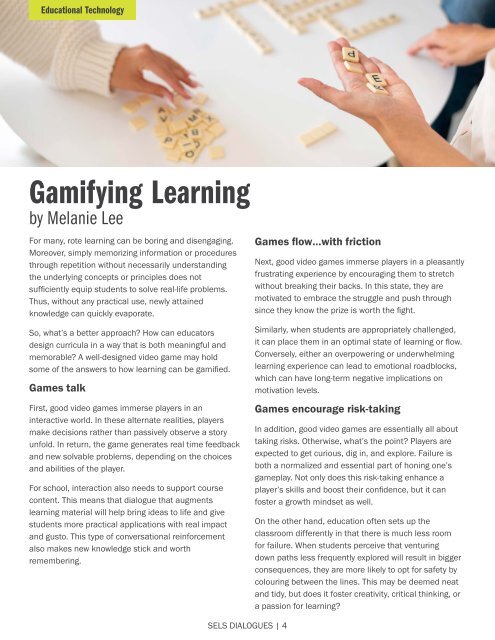SELS Dialogues Journal Volume 3 Issue 1
A diverse collection of articles, each offering a unique perspective and contributing to the ever-expanding landscape of knowledge and creativity.
A diverse collection of articles, each offering a unique perspective and contributing to the ever-expanding landscape of knowledge and creativity.
You also want an ePaper? Increase the reach of your titles
YUMPU automatically turns print PDFs into web optimized ePapers that Google loves.
Educational Technology<br />
Gamifying Learning<br />
by Melanie Lee<br />
For many, rote learning can be boring and disengaging.<br />
Moreover, simply memorizing information or procedures<br />
through repetition without necessarily understanding<br />
the underlying concepts or principles does not<br />
sufficiently equip students to solve real-life problems.<br />
Thus, without any practical use, newly attained<br />
knowledge can quickly evaporate.<br />
So, what’s a better approach? How can educators<br />
design curricula in a way that is both meaningful and<br />
memorable? A well-designed video game may hold<br />
some of the answers to how learning can be gamified.<br />
Games talk<br />
First, good video games immerse players in an<br />
interactive world. In these alternate realities, players<br />
make decisions rather than passively observe a story<br />
unfold. In return, the game generates real time feedback<br />
and new solvable problems, depending on the choices<br />
and abilities of the player.<br />
For school, interaction also needs to support course<br />
content. This means that dialogue that augments<br />
learning material will help bring ideas to life and give<br />
students more practical applications with real impact<br />
and gusto. This type of conversational reinforcement<br />
also makes new knowledge stick and worth<br />
remembering.<br />
Games flow…with friction<br />
Next, good video games immerse players in a pleasantly<br />
frustrating experience by encouraging them to stretch<br />
without breaking their backs. In this state, they are<br />
motivated to embrace the struggle and push through<br />
since they know the prize is worth the fight.<br />
Similarly, when students are appropriately challenged,<br />
it can place them in an optimal state of learning or flow.<br />
Conversely, either an overpowering or underwhelming<br />
learning experience can lead to emotional roadblocks,<br />
which can have long-term negative implications on<br />
motivation levels.<br />
Games encourage risk-taking<br />
In addition, good video games are essentially all about<br />
taking risks. Otherwise, what’s the point? Players are<br />
expected to get curious, dig in, and explore. Failure is<br />
both a normalized and essential part of honing one’s<br />
gameplay. Not only does this risk-taking enhance a<br />
player’s skills and boost their confidence, but it can<br />
foster a growth mindset as well.<br />
On the other hand, education often sets up the<br />
classroom differently in that there is much less room<br />
for failure. When students perceive that venturing<br />
down paths less frequently explored will result in bigger<br />
consequences, they are more likely to opt for safety by<br />
colouring between the lines. This may be deemed neat<br />
and tidy, but does it foster creativity, critical thinking, or<br />
a passion for learning?<br />
<strong>SELS</strong> DIALOGUES | 4















